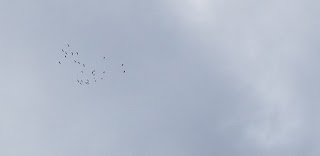If you're out prepping your garden bed for winter, listen closely. A little more closely! Alongside the noise of the city and up in the sky, you might here a chorus of trills. Look up! Those hauntingly primeval sounds might be those of the
Sandhill Crane (
Antigone canadensis).
Yes, we have cranes in the Chicago region! And right around Thanksgiving is one of the best times to see flocks of them flying over (figure 1) as they make their way south for the winter. In fact, over
80,000 of these elegant, heron-like birds with wingspans in excess of 6 feet fly over the Chicago region during fall and spring migration each year.
 |
| Figure 1: A flock of migrating Sandhill Cranes in flight. |
If you are a city dweller, more often than not the best view you'll get of these birds is like the one shown in Figure 1. As such, people often confuse them with geese. However, just a few extra moments of observation is all that is needed to distinguish clumsy Canada Geese (
Branta canadensis) from graceful sandhill cranes. First off all, geese do not make trill calls, but rather loud honking calls. Second, geese often fly much lower in the sky and often land in urban parks, lawns, or ponds, whereas Sandhill Cranes seldom land in the city. To see sandhill cranes on the ground or up-close, one often must venture 30 or 40 minutes by car out to the suburbs where they sometimes will land (or even breed), unusually in a Forest Preserve, such as the ones shown in figure 2. However, sometimes you might be lucky to see one land in the city, and the best places to look are larger parks with open grassy spaces.
 |
| Figure 2: Sandhill Cranes in a field in the suburbs of Chicago. Photo credits: Forest Preserves of Cook County |
Sandhill cranes spend their winters along the Gulf Coast into Florida, and they breed in the summer in various locations across the plains and upper Midwest into Canada. Chances are, all of the cranes that you might see flying over Chicago during the fall are going to take an overnight "rest stop" at a site in Indiana located only 2 hours southeast of Chicago by car, known as the
Jasper-Pulaski Fish & Wildlife Area. Here, they gather by the tens of thousands (if not more) and can be viewed from a large observation platform. If you have access to a vehicle and are up for driving 2 hours into a fallowed field in rural Indiana, it is well-worth the trip!
But even if you can't make it out to a larger green-space in the outskirts of the city, the next time you are raking leaves or admiring the last of fall colors in your neighborhood park, listen closely and look up and you might see and hear one of the last harbingers of fall flying over your hood, the Sandhill Crane.





Comments
Post a Comment